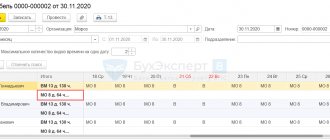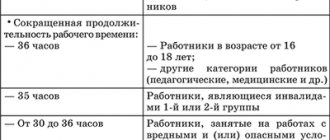What is working time
The basic state law establishes the right of citizens to work, as well as the specifics of working hours and rest. At the same time, this right involves limiting the time that applies to a worker, as well as allowing workers to use weekends and holidays for rest.
The definition of “working hours” is reflected in Art. 91 of the Labor Code, it means the period of time during which the employee has the authority to perform labor duties determined by the internal labor regulations and the employment contract that forms the basis of the legal relationship that has arisen. Such time may also include other time periods that are established as such by legislative norms.
Other working periods may include the time employees are idle, the time of a paid break provided during work, the period of business trips, rest periods between shifts, etc.
Legislative regulation of working time aims to achieve:
- productive use of the time period for carrying out work;
- protecting the health and performance of workers hired under employment contracts;
- increasing the professionalism of performers engaged in joint hired labor.
Preparatory stage
The preparatory stage begins long before the employee’s first day of work begins - from the moment the manager submits an application to find a new employee. And the recruiter starts working on the vacancy.
The manager prepares an induction plan for a new employee. It necessarily includes adaptation measures and tasks that are assigned to the newcomer during the probationary period. For example, familiarize yourself with the regulations and internal documents of the department and the company as a whole, take an introductory sales training course, study the history and structure of the company, etc.
Photo courtesy of Atlant Telecom
The plan indicates who is responsible for each activity and the deadlines for completing tasks. The plan also contains a conclusion about completion of the probationary period.
On the day the hiring decision is made, the recruiter sends the candidate a letter confirming the date of entry to work, a list of documents required for registration with the staff, and a request to prepare an electronic self-presentation (future position, education, previous experience, achievements, expectations from the upcoming arrival at work).
Self-presentation is shown to future colleagues - it helps them get to know the new employee.
Mode elements
Working hours refer to the period of time during which an employed employee has an obligation to perform the functions assigned to him by the employer. The legal standard for such a time period must be understood as the standard work time established by the legislator.
The provisions of the Labor Code establish as time standards in which employees can be busy performing the functions assigned to them: working week, shift (day), accounting period.
A working week is understood as a period of working time falling within a calendar week. Legislative norms limited this time period to 40 hours. This standard applies to the work week, regardless of whether it is 5 or 6 days. This standard of hours falls under the definition of a normal working week, which, as a rule, contains 2 days off.
A shortened or incomplete week can be established by agreement of the parties and represents a part-time working regime.
The establishment of six-day work is preceded by a necessity determined by the conditions of production or performance of work. This standard is typical for educational, medical or social institutions. A distinctive feature of the “six-day week” is the reduction of the working day preceding a weekend or holiday to 5 hours.
The presence of shift work conditions implies the establishment of work shifts, that is, such work intervals during which some workers performing the functions necessary for a single technological process are replaced by others. In this case, we can talk about day and night shifts. Shift work is typical for those types of production that are considered continuous.
It is necessary to change the working hours if there are shifts, within the framework of current legal norms, on the eve of a non-working day, holiday and day off, as well as when performing work on the night shift.
Types of working hours
The provisions of the Labor Code define the types of working time used:
- usual - depending on the system by which work time is recorded. Most often it is reflected in a 5 or 6-day work week.
- Irregular – established for certain categories of workers, by order of the manager. This type cannot be installed on a permanent basis.
- Flexible - allowed in individual teams and departments, on the basis of self-regulation. The flexible working time regime should not contradict the legislative principles on the total number of hours worked. Flexible working hours may be temporary.
- Shift work is a working time regime in which employees can work in several shifts and in an equal number of hours.
- Shift work is a regime and recording of working hours of a special type, which is typical for performing work outside the place of primary residence, which means it is impossible to return to the place of residence every day.
- Divisible – characteristic of work with different types of intensity.
Part-time working hours can be established at the request of the employee. Pregnant women, parents of children (under 14 years of age) and persons caring for sick relatives can petition management and ask for a part-time working schedule.
The introduction of a part-time working regime falls within the competence of the company’s management, which is formalized by order. An order to change working hours, based on an exclusive decision of management, may have signs of a change in significant working conditions.
Article 94 of the Labor Code of the Russian Federation - Duration of daily work (shift)
The duration of daily work (shift) cannot exceed:
- for workers aged from fifteen to sixteen years - 5 hours, for workers aged from sixteen to eighteen years - 7 hours;
- for students in basic general education programs and educational programs of secondary vocational education, combining education with work during the academic year, from fourteen to sixteen years old - 2.5 hours, from sixteen to eighteen years old - 4 hours;
- for disabled people - in accordance with a medical report issued in the manner established by federal laws and other regulatory legal acts of the Russian Federation.
For workers engaged in work with harmful and (or) dangerous working conditions, where reduced working hours are established, the maximum permissible duration of daily work (shift) cannot exceed:
- with a 36-hour work week - 8 hours;
- with a 30-hour work week or less - 6 hours.
An industry (inter-industry) agreement and a collective agreement, as well as with the written consent of the employee, formalized by concluding a separate agreement to the employment contract, may provide for an increase in the maximum permissible duration of daily work (shift) compared to the duration of daily work (shift) established by part the second of this article for workers engaged in work with harmful and (or) dangerous working conditions, subject to compliance with the maximum weekly working hours established in accordance with parts one - three of Article 92 of this Code:
- with a 36-hour work week - up to 12 hours;
- with a 30-hour work week or less - up to 8 hours.
Duration of daily work (shift) of creative workers of the media, cinematography organizations, television and video crews, theaters, theatrical and concert organizations, circuses and other persons involved in the creation and (or) performance (exhibition) of works, in accordance with the lists jobs, professions, positions of these workers, approved by the Government of the Russian Federation, taking into account the opinion of the Russian Tripartite Commission for the Regulation of Social and Labor Relations, can be established by a collective agreement, a local regulatory act, or an employment contract.
Duration of daily work (shift) for certain categories of workers
The legislator has determined the maximum amount of time that certain categories of employed people can spend at work.
Young people aged 15 to 16 years and from 16 to 18 years old cannot have a work shift of more than 5 and 7 hours, respectively. Teenagers who are students, as well as those whose age is between 14 and 16 years old - no more than 2.5 hours, and students whose age is 16-18 years old - no more than 4 hours. The duration of the shift for disabled people is determined by a medical report.
The harmfulness or danger of work is a reason to reduce working hours to 8 hours per shift, with 36 working hours per week, and to 6 hours per shift, with 30 working hours per week.
Certain features also exist regarding the work of creative teams. Such persons carry out their work under the conditions established by local acts, collective and labor agreements.
Working hours were longer for men than for women
As follows from the results of the study available to RG, the largest difference in the number of hours worked is observed in four regions of the North-West.
All four subjects belong to the Arctic territories. And in the regions of the Far North, according to the Labor Code, women’s working hours, in principle, should not exceed 36 hours a week. In addition, at the level of subjects or individual companies, additional measures are taken to support women, for example, on special days, when schools or kindergartens are closed due to frost, women are often allowed to stay at home with their children and not go to work. Hence the strong disproportion. But there are additional nuances.
Thus, in the Nenets Autonomous Okrug, men work on average 1 hour 50 minutes longer than women. On average, their shift is almost seven hours, while for women it is just over five. This is due to several factors. Thus, in the Nenets Autonomous Okrug there are many mining enterprises where mostly men work, and on a rotational basis.
Women also come on duty, but there are relatively few of them; women work at enterprises as cooks, administrators, and nurses.
In addition, reindeer herding is widespread among the indigenous population in the Nenets Autonomous Okrug. In practice, it looks like this: several men lead the reindeer to the nomadic places, and the plague workers provide for their daily life. Both the reindeer herder and the plague worker are official professions, and the working hours for men and women in reindeer herding are the same. But at the same time, women in the Nenets Autonomous Okrug are increasingly refusing the fate of plague workers; accordingly, in some communities, men are learning to provide for their daily lives during nomads on their own.
And women in the Nenets Autonomous Okrug are increasingly choosing a different field of activity: they work in kindergartens, schools, and get jobs as cooks in small bakeries that open even in the most remote villages.
In Karelia, men work longer than women by 1 hour and 37 minutes. The region also has its own nuances. Thus, the basis of the republic’s GRP is mining and manufacturing industries, where mostly men work at the machines. In a number of small towns, women often take part-time jobs, for example, as cleaners in small companies.
In the Komi Republic, men work longer than women by 1 hour 35 minutes; this figure is also explained by the prevalence of the rotation method in mining companies. The fourth region with the largest difference is the Murmansk region, where women work 1 hour 32 minutes less than men.
The longest working day in the country is 8 hours 1 minute for men in the Kaliningrad region. This is the only region in the country where, according to statistics, men work a 40-hour work week. For women, working hours are 37 hours 6 minutes. In other regions, the average is 37-38 hours, and in many regions the length of the working week is falling.
Experts explain this by the fact that a number of employers have begun to transfer employees to part-time positions.
In St. Petersburg, women work on average 50 minutes a day less than men; in Moscow, the difference is half an hour.
The only region in the country where women worked longer hours than men was Chechnya. Here, ladies work on average seven hours a day, and men - 6 hours 52 minutes.
Regulation of working hours
Carrying out actions entailing a change in working hours falls within the competence of the management of the legal entity. As a rule, such changes are based on local or national legal acts.
Working hours, as well as part-time working hours, are established at each specific enterprise, depending on the specifics of its work.
The approval of the features of the working time regime is within the competence of the governed by and is a change in essential working conditions, in the event that before the change in the working time regime occurred, there was a different regime.
Part-time working hours are established for individual categories, based on their application. It is possible to establish a part-time working regime for the entire workforce only in accordance with the procedure for making changes related to essential working conditions.
Cancellation of the part-time working regime may be established by an order establishing it, and in relation to certain categories of workers, by a separate order based on their application.
How does the first working day begin?
On the first day of work, a recruiter is greeted by a recruiter who has previously accompanied him at all stages of interviews and hands him a recruiter’s folder . It contains a memo with information about the company, a company notebook/diary, a pen and a brochure with the company’s brand code. The recruiter then accompanies the newcomer to a human resources specialist to complete paperwork.
On the same day, the recruiter sends the new employee to his corporate email address a link to the electronic database of the company’s main regulations. All necessary training and adaptation materials to help a new employee are stored there.
Each newcomer undergoes a training session . We called it "Guide". It is held once a month and introduces visiting employees to the history of the company and components of the brand, company structure, corporate culture, and personnel policy. The meetings are conducted by HR department employees and the brand manager.
In order for newcomers to quickly master a new profession and the requirements of the company, training courses are held for them on introduction to the profession. This is training in sales, connection and customer service. It is attended by a business coach, managers and company experts.

Photo courtesy of Atlant Telecom
No later than 5 working days before the end of the probationary period, we hold a final meeting in the format of a conversation: together with the manager, mentor, HR manager, and in some cases, experts from related departments.
Previously, the HR manager surveys the meeting participants, clarifying everyone’s opinion about the results of the newcomer’s adaptation to the profession and. In addition to discussing the knowledge acquired and the results achieved, the employee is given feedback. And the newcomer tells how much his expectations from the company and work in this position were met, how he himself evaluates his achievements, what difficulties there were in his work and what helped him cope with them.
After which a decision is made to complete the probationary period. There are cases when, after its completion, a decision is made to extend adaptation for a specific period.
We always congratulate all employees who successfully complete their probationary period with a corporate souvenir and also send out an e-mail of congratulations.
Results that were achieved, including thanks to the implementation of adaptation measures, in 2021 - compared to 2013:
- The number of newcomers who successfully completed the probationary period increased by 35%. Now 96% of newcomers remain working in the company
- Reduced staff turnover rate by 45%
- Increase in the average life expectancy of an employee in the company: by 75%
- There was a reduction in personnel costs by 25%. Personnel profitability (the ratio of personnel costs to revenue) increased by 64%
It may be noted that by the end of 2021 we plan that revenue in dollar terms will grow by 23% compared to 2013.
Internal labor regulations
These rules relate to local acts adopted and approved at each individual enterprise. When approving the specifics of working hours, they are reflected in the VTR rules. Employees of enterprises are obliged to perform their labor functions in full compliance with established rules.
Familiarization with them is carried out by the person employing the employee, of which the latter is notified against his signature. Failure to comply with these rules may be grounds for dismissal of an employee who violates the company’s work schedule.
Regime of working hours and rest time for employees with a special nature of work
Features of the production cycle and the nature of labor, categories of workers, their age and other factors are the basis for the use of different regimes of work and rest time.
Some types of work are characterized by the presence of special breaks, which are based on the complexity or harmfulness of the work functions performed. A separate work and rest regime established for certain categories of workers engaged in special work is reflected in industry and federal industry agreements that extend to certain production areas.







